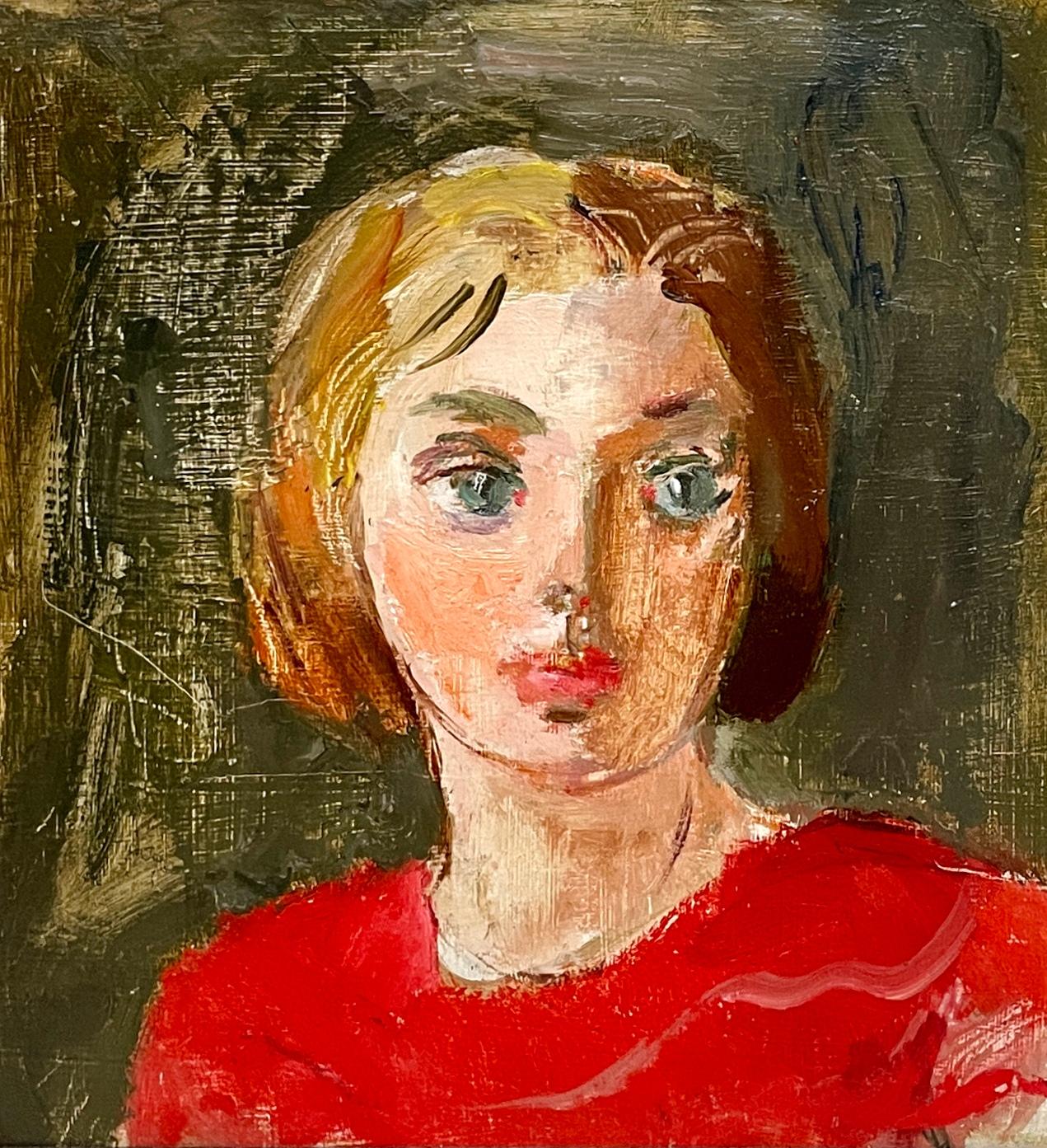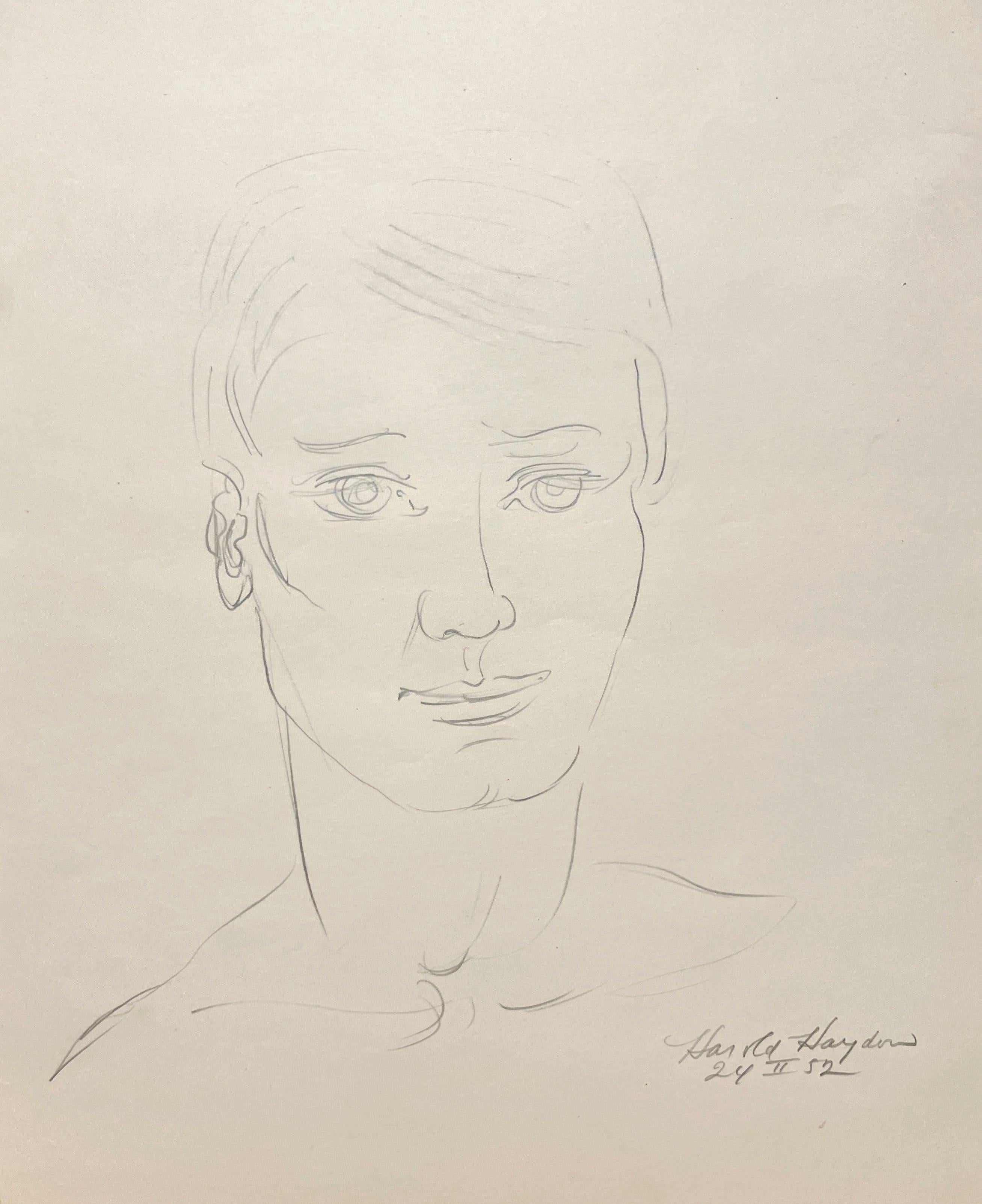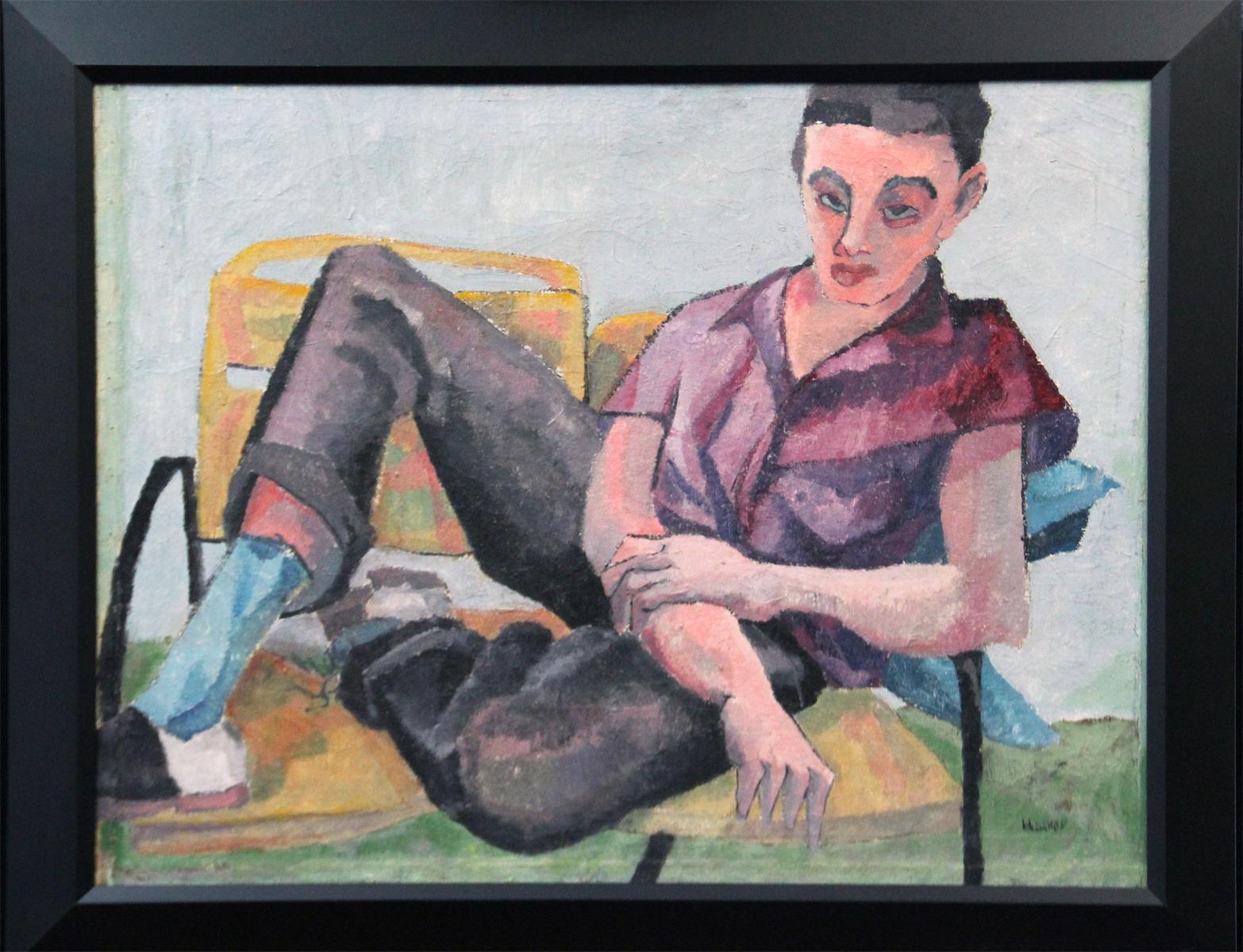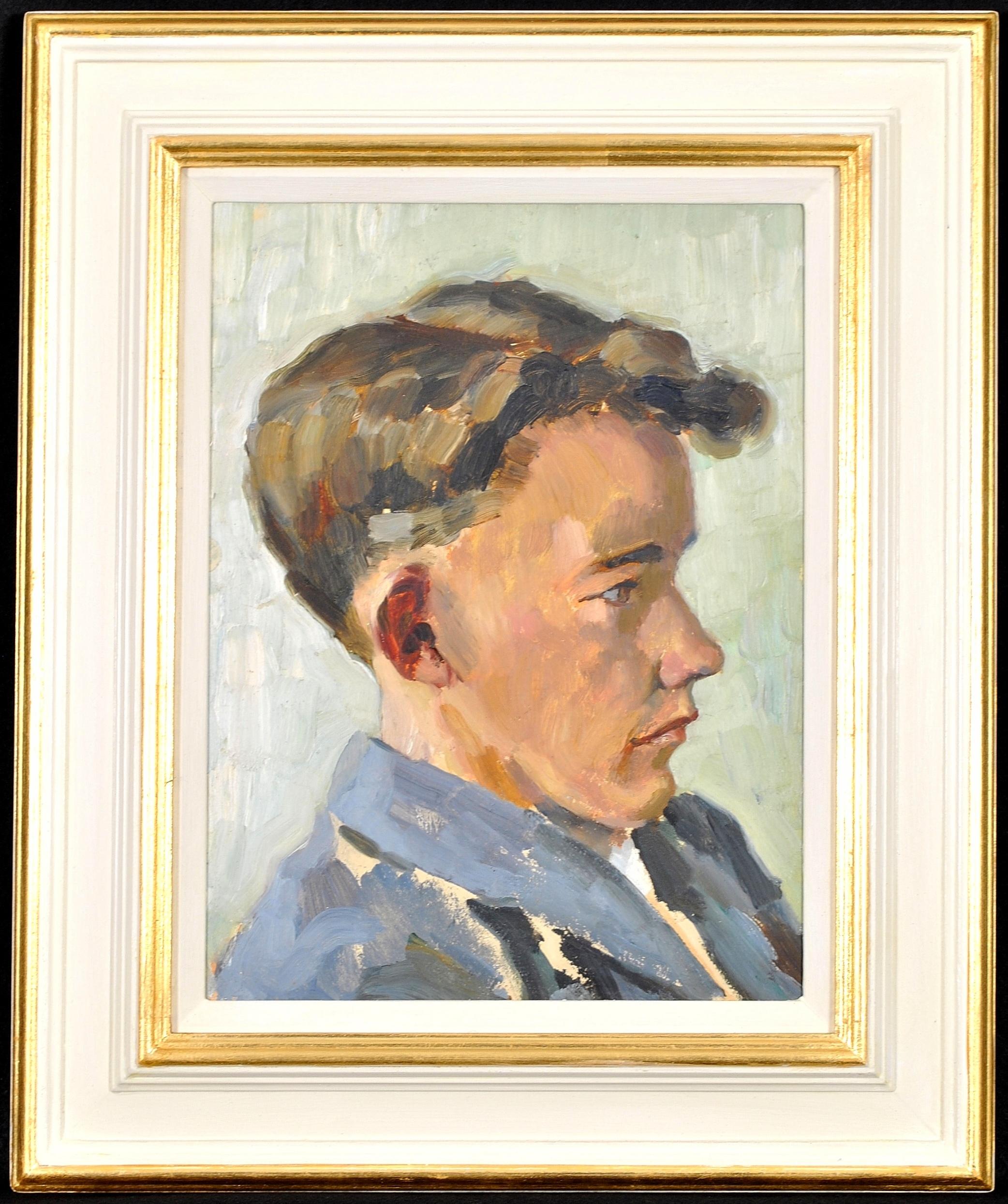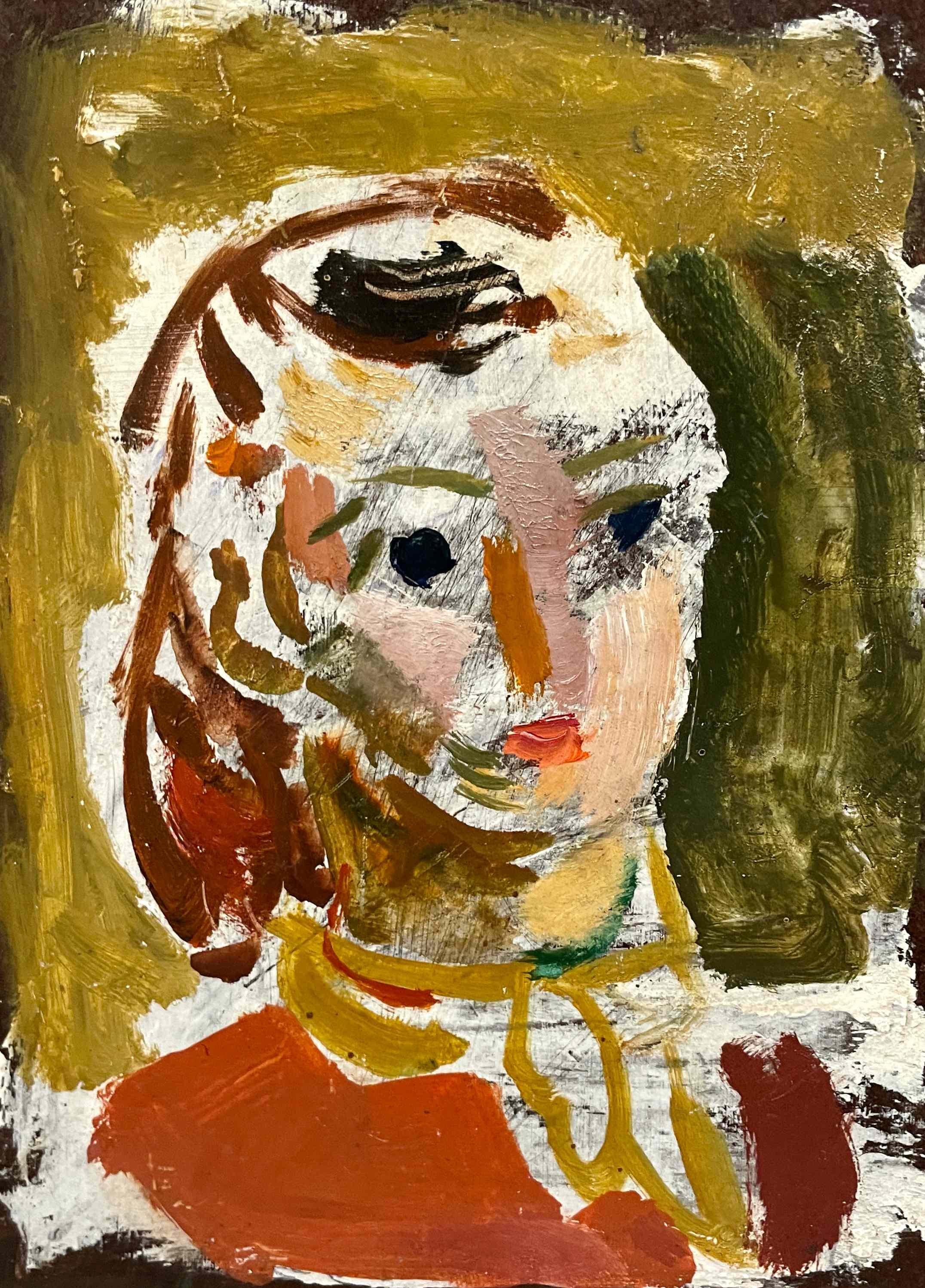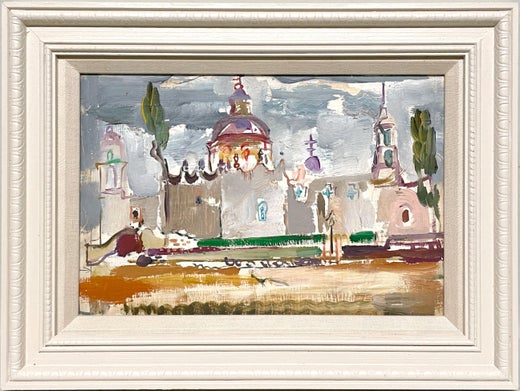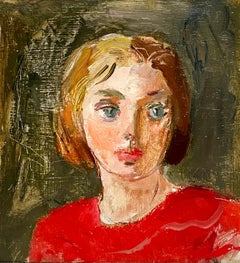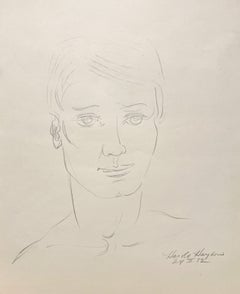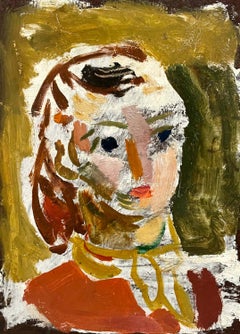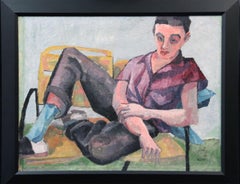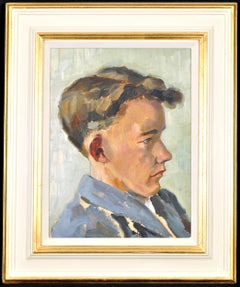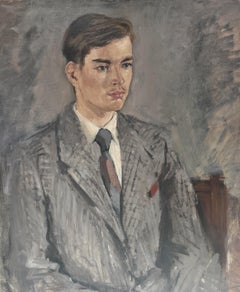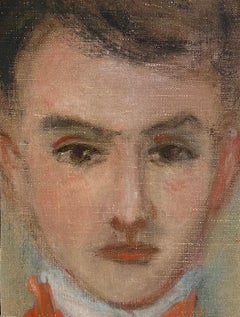Items Similar to A Charming Mid-Century Modern Portrait of a Young Man by Francis Chapin
Want more images or videos?
Request additional images or videos from the seller
1 of 13
Francis ChapinA Charming Mid-Century Modern Portrait of a Young Man by Francis ChapinCirca 1965
Circa 1965
$650
£490.85
€561.98
CA$917.97
A$1,002.20
CHF 525.41
MX$12,172.15
NOK 6,561.57
SEK 6,195.87
DKK 4,194.60
About the Item
A Charming, 1960s Mid-Century Modern Portrait of a Young Man by Francis Chapin (Am. 1899-1965). With wonderful expressionist brushwork and a vibrant palette, the painting most likely depicts a portrait of the artist's son, Todd Kinsley Chapin, as a young man. Artwork Size: 14 1/4” x 12 3/4” (Framed size: 15 1/4 x 13 3/4”). Estate stamped on reverse. Provenance: Estate of the artist.
Francis Chapin, affectionately called the “Dean of Chicago Painters” by his colleagues, was one of the city’s most popular and celebrated painters in his day. Born at the dawn of the 20th Century in Bristolville, Ohio, Chapin graduated from Washington & Jefferson College near Pittsburgh, Pennsylvania before enrolling at the Art Institute of Chicago in 1922. He would set down deep roots at the Art Institute of Chicago, exhibiting there over 31 times between 1926 and 1951. In 1927 Chapin won the prestigious Bryan Lathrop Fellowship from the Art Institute – a prize that funded the artist’s yearlong study trip to Europe. Upon his return to the United States, Chapin decided to remain in Chicago, noting the freedom Chicago artists have in developing independently of the pressure to conform to pre-existing molds (as was experienced by artists in New York, for example). Chapin became a popular instructor at the Art Institute, teaching there from 1929 to 1947 and at the Art Institute’s summer art school in Saugatuck, Michigan (now called Oxbow) between 1934 – 1938 (he was the director of the school from 1941-1945). From 1951 to 1953, Chapin worked as the artist-in-residence at the University of Georgia, Athens, where he painted numerous images of the American South. Chapin’s contemporaries among Chicago’s artists included such luminaries as Ivan Le Lorraine Albright, Edgar Miller, William S. Schwartz and Aaron Bohrod among others.
A prolific painter, Chapin produced numerous works while traveling in Mexico, France, Spain, Saugatuck and Martha’s Vineyard, where he frequently spent his summers and taught at the Old Sculpin Gallery there. Chapin was best recognized for his dynamic and vibrant images of Chicago during the 1930s and 40s. Chapin was a resident of the Old Town neighborhood where he lived and kept his studio on Menomonee Street for many years. Described as a “colorful figure, nearly 6 feet 6 inches tall, and thin, and usually wearing tweeds”, it is easy to imagine Chapin at work observing the busy street life of the city.
In addition to his many exhibitions at the Art Institute of Chicago, Chapin’s work was shown during his lifetime at such institutions as the Pennsylvania Academy of Fine Arts, Philadelphia; the Corcoran Gallery, Washington, D.C.; the National Academy of Design, New York; the Museum of Modern Art, New York; the Whitney Museum of American Art, New York and the Carnegie Institute, Pittsburgh, among others. Francis Chapin’s paintings are represented in the collections the Art Institute of Chicago; the Friedman Collection, Chicago; the Butler Institute of American Art, Youngstown; the Denver Art Museum; the Everson Museum of Art, Syracuse; the Norton Museum of Art, West Palm Beach; the Telfair Museum of Art, Savannah and the Brooklyn Museum of Art, among others.
- Creator:Francis Chapin (1899-1965, American)
- Creation Year:Circa 1965
- Dimensions:Height: 15.25 in (38.74 cm)Width: 13.75 in (34.93 cm)Depth: 1.5 in (3.81 cm)
- Medium:
- Movement & Style:
- Period:
- Condition:Very good / fine original estate condition. See photos.
- Gallery Location:Chicago, IL
- Reference Number:Seller: #219261stDibs: LU2591216535492
Francis Chapin
Francis Chapin, affectionately called the “Dean of Chicago Painters” by his colleagues, was one of the city’s most popular and celebrated painters in his day. Born at the dawn of the 20th Century in Bristolville, Ohio, Chapin graduated from Washington & Jefferson College near Pittsburgh, Pennsylvania before enrolling at the Art Institute of Chicago in 1922. He would set down deep roots at the Art Institute of Chicago, exhibiting there over 31 times between 1926 and 1951. In 1927 Chapin won the prestigious Bryan Lathrop Fellowship from the Art Institute – a prize that funded the artist’s yearlong study trip to Europe. Upon his return to the United States, Chapin decided to remain in Chicago, noting the freedom Chicago artists have in developing independently of the pressure to conform to pre-existing molds (as was experienced by artists in New York, for example). Chapin became a popular instructor at the Art Institute, teaching there from 1929 to 1947 and at the Art Institute’s summer art school in Saugatuck, Michigan (now called Oxbow) between 1934 – 1938 (he was the director of the school from 1941-1945). A prolific painter, Chapin produced numerous works while traveling in Mexico, France, Spain, Saugatuck and Martha’s Vineyard, where he frequently spent summers and taught at the Old Sculpin Gallery there. Chapin was best recognized for his dynamic and vibrant images of Chicago during the 1930s and 40s. Chapin was a resident of the Old Town neighborhood where he lived and kept his studio on Menomonee Street for many years. Described as a “colorful figure, nearly 6 feet 6 inches tall, and thin, and usually wearing tweeds”, it is easy to imagine Chapin at work observing the busy street life of the city. In addition to his many exhibitions at the Art Institute of Chicago, Chapin’s work was shown during his lifetime at such institutions as the Pennsylvania Academy of Fine Arts, Philadelphia; the Corcoran Gallery, Washington, D.C.; the National Academy of Design, New York; the Museum of Modern Art, New York; the Whitney Museum of American Art, New York and the Carnegie Institute, Pittsburgh, among others. Francis Chapin’s paintings are represented in the collections the Art Institute of Chicago; the Friedman Collection, Chicago; the Butler Institute of American Art, Youngstown; the Denver Art Museum; the Everson Museum of Art, Syracuse; the Norton Museum of Art, West Palm Beach; the Telfair Museum of Art, Savannah and the Brooklyn Museum of Art, among others.
About the Seller
5.0
Recognized Seller
These prestigious sellers are industry leaders and represent the highest echelon for item quality and design.
Established in 2000
1stDibs seller since 2023
92 sales on 1stDibs
Typical response time: <1 hour
- ShippingRetrieving quote...Shipping from: Chicago, IL
- Return Policy
Authenticity Guarantee
In the unlikely event there’s an issue with an item’s authenticity, contact us within 1 year for a full refund. DetailsMoney-Back Guarantee
If your item is not as described, is damaged in transit, or does not arrive, contact us within 7 days for a full refund. Details24-Hour Cancellation
You have a 24-hour grace period in which to reconsider your purchase, with no questions asked.Vetted Professional Sellers
Our world-class sellers must adhere to strict standards for service and quality, maintaining the integrity of our listings.Price-Match Guarantee
If you find that a seller listed the same item for a lower price elsewhere, we’ll match it.Trusted Global Delivery
Our best-in-class carrier network provides specialized shipping options worldwide, including custom delivery.More From This Seller
View AllA Compelling '50s Mid-Century Modern Portrait of a Young Woman by Francis Chapin
By Francis Chapin
Located in Chicago, IL
A Compelling '50s Mid-Century Modern Portrait of a Young Woman by Francis Chapin. Titled "Red Dress", the painting is oil on Masonite and dates circa 1950. A very well executed, co...
Category
Mid-20th Century American Modern Figurative Paintings
Materials
Masonite, Oil
A Sensitive 1950s Mid-Century Modern Portrait of a Young Man By Harold Haydon
By Harold Haydon
Located in Chicago, IL
A Sensitive, Finely Rendered 1950s Mid-Century Modern Portrait of a Young Man By Noted Chicago Artist, Harold Haydon (Am. 1909-1994). Artwork size: 12 x 9 1/2 inches. Artwork is un...
Category
Mid-20th Century American Modern Portrait Drawings and Watercolors
Materials
Paper, Graphite
A Charming 1950s Modern Portrait of a Young Woman by Francis Chapin
By Francis Chapin
Located in Chicago, IL
A Charming, 1950s Modern Portrait of a Young Woman in a Red Sweater by Noted Chicago Artist, Francis Chapin (Am. 1899-1965). Artwork size: 8” x 6”, Oil on Masonite (Framed size: 11...
Category
Mid-20th Century American Modern Figurative Paintings
Materials
Masonite, Oil
A Charming, 1950s Expressionist Portrait of a Young Girl by Francis Chapin
By Francis Chapin
Located in Chicago, IL
A Charming, 1950s Expressionist Portrait of a Young Girl by Noted Chicago Modern Artist, Francis Chapin (Am. 1899-1965). A Wonderful and intimate Mid-Century studio portrait of a yo...
Category
Mid-20th Century American Modern Figurative Paintings
Materials
Masonite, Oil
A Fabulous Mid-Century Modern Portrait of a Woman by Noted Artist Francis Chapin
By Francis Chapin
Located in Chicago, IL
A Fabulous Mid-Century Modern Portrait of a Young Woman by Noted Chicago Artist, Francis Chapin (Am. 1899-1965). Depicting a wonderfully fashionable woman dressed in a red sweater, ...
Category
Mid-20th Century American Modern Figurative Paintings
Materials
Masonite, Oil
Charming Mid-Century Modern 1950s Portrait of a Young Girl by Francis Chapin
By Francis Chapin
Located in Chicago, IL
A charming, beautifully painted, Mid-Century Modern portrait of a young girl by noted Chicago artist, Francis Chapin. Dating from the 1950s, the painting was exhibited at the famed ...
Category
Mid-20th Century American Modern Portrait Paintings
Materials
Canvas, Oil
You May Also Like
Young Man, Expressionist Portrait by Philadelphia Artist
By Bernard Harmon
Located in Doylestown, PA
"Young Man" is an oil on canvas portrait painting by Philadelphia born Expressionist painter Bernard Harmon. The painting is 26" x 36" in size, signed on the lower right. Figurative ...
Category
1950s Expressionist Portrait Paintings
Materials
Oil, Canvas
Portrait of a Young Man - Modern British Impressionist Oil on Board Painting
Located in Sevenoaks, GB
* No US duty or taxes to pay on this item *
A beautiful 1950's Modern British oil on board portrait of a young man wearing a blue jacket. Excellent quality portrait which is present...
Category
1950s Portrait Paintings
Materials
Oil, Board
René Mels (1909-1977) Portrait of a young man, oil on canvas signed
Located in Paris, FR
René Mels (1909-1977)
Portrait of a young man,
signed lower right
oil on canvas
73 x 60 cm
Framed : 77.5 x 64.5
This impressive portrait is obviously tou...
Category
1940s Modern Portrait Paintings
Materials
Oil
Portrait of a Young Man Original French Artwork Acrylic Painting
By Robert Ladou
Located in Cirencester, Gloucestershire
Original French Artwork
by Robert Ladou (French 1929-2014)
original acrylic painting on unstretched canvas stuck on paper, unframed
overall size: 12.5 x 9.5 inches
size: 6 x 4.5 inc...
Category
20th Century Portrait Paintings
Materials
Acrylic
Vintage Original Oil Painting of Young Man Signed
Located in West Palm Beach, FL
A fabulous vintage original oil painting. A chic composition of a your man in cool clear colors. Signed and dated by the artist. Acquire...
Category
Mid-20th Century Mid-Century Modern Paintings
Materials
Paint
$1,160 Sale Price
20% Off
Portrait of a Young Man Oil Painting Celebrated 20th Century Artist
By Oliver Messel
Located in London, GB
Oliver Messel
1904 - 1978
Portrait of a Young Man
Oil on canvas, signed and dated 'Oliver Messel 1930' (on the stretcher)
Image size: 30 x 25 inches (76.2 x 63.4 cm)
Original frame
Oliver Messel was born to Leonard and Maud Messel, née Sambourne, on the 13 January 1904 and was the youngest of three children. The family moved to Nymans, the Messel family home in Sussex, from nearby Balcombe in 1915. The house remained in the family until 1953 when it was bequeathed to the National Trust, following a fire in 1947 which destroyed a large portion of the house.
The Messels originated from a line of German Jewish bankers on Leonard’s side, however, both family lines boast a number of artistic influences, including Maud’s father. Maud was brought up at 18 Stafford Terrace, Kensington (now known as the Linley Sambourne House Museum), amongst collections of antique porcelain and eighteenth-century furniture, and with a host of artistic visitors such as Henry Irving and Oscar Wilde.
Oliver’s own upbringing appears to be influenced by his mother's, as the Messel family were also affiliated with artists and writers and were keen collectors of art, filling their home with textiles, paintings and collections of European and Asian fans from travels abroad. It was amongst such treasures that Oliver, Anne and Linley spent their childhood, in addition to the beauty of Nyman’s extensive gardens.
Oliver was schooled at Eton but rather than going up to university was encouraged by family friends, gallery owner Archie Propert and painter and sculptor Glyn Philpot, to attend art school. In 1922 he enrolled at the Slade School of Fine Art in London, where he studied under Henry Tonks. Here, he met the artist Rex Whistler with whom he remained firm friends until Whistler’s death in WW2.
Upon leaving the Slade in 1924 Oliver was apprenticed to the studio of portrait artist John Wells, where he learnt various Old Master painting techniques, and met artists such as Jacob Epstein, Augustus John and William Orpen.
Whilst at the Slade Oliver developed his interest in Papier Mâché masks, a pastime popular amongst many art students at the time. Whilst apprenticed to artist John Wells several of Oliver’s masks were exhibited at the Claridge Gallery, London, alongside pieces by Whistler and other young artists. These were seen by Serge Diaghilev, director of the Ballet Russes, and Charles B. Cochran, a theatrical producer, both of whom made Oliver offers of work.
His first job in the theatre was creating masks for the Ballets Russes’ Zéphyr et Flore, 1925, designed by the French artist Georges Braque, followed by numerous musical revues for Cochran, including Wake Up and Dream!, 1929, with music by Cole Porter. It was during these revues, working with Porter and Noel Coward, that Oliver also began to design headdresses and costumes. In 1932 he was rewarded with his first full commission to design both costume and sets for Helen!, directed by Max Reinhardt. The production design is still celebrated today for its innovative approach and ground-breaking ‘white on white’ aesthetic, which referenced ‘Greek temples, Rococo drapes, Baroque colonnades and Louis XIV carousels’.
The success of Helen! led to further offers within the theatre including Reinhardt’s version of A Midsummer Night’s Dream at the Old Vic in 1937, starring Vivien Leigh as Titania and Robert Helpmann as Oberon, the Jean Cocteau play The Infernal Machine in 1940, and Christopher Fry’s translation of Jean Anouilh’s Ring Round the Moon, 1950.
One of Oliver’s best-known productions during this period was the Russian ballet The Sleeping Beauty, performed by Sadler’s Wells Ballet in 1946 at the Royal Opera House, Covent Garden. Encompassing over 200 costumes and four set changes, Oliver’s romantic designs were celebrated for bringing colour back to post-war London, and variations on his designs are still used today. Additional designs for the ballet included Comus in 1940, for which he was released from war duties, and Homage to the Queen, choreographed by Frederick Ashton and performed in 1953 for the Queen’s coronation.
His first opera was in 1940 for Mozart’s Die Zauberflöte at the Royal Opera House, followed by a series of productions at the newly founded Glyndebourne Opera House in Sussex, for which Oliver also designed the proscenium arch. He triumphed in 1956 designing a season of four different productions for their Mozart bicentennial, also providing illustrations for the programme covers.
His popularity also spread beyond theatre to film, were he worked on over eight different feature films including Romeo and Juliet, 1936, directed by George Cukor. During a three-month research trip to Italy Oliver collected over 3,000 reference images including postcards of artwork by Piero della Francesca, Giovanni Bellini and Leonardo da Vinci, along with prints and photographs of textiles and architectural features.
A production of Gabriel Pascal’s Caesar and Cleopatra, 1946, starring Vivien Leigh and Claude Rains, was celebrated for Oliver’s ability to recreate the opulence and luxury of ancient Egypt under the constraints of wartime rationing. Such was his skill that Vivien Leigh in a letter to Oliver declared that “I have of course told Pascal that nobody in the world must do the costumes except you.” He was later nominated for an Academy Award for his work on his final film Suddenly, Last Summer, 1959; an adaptation of Tennessee Williams’ American Southern Gothic mystery.
Having started his artistic career as a portrait apprentice, capturing the faces of family and friends, Oliver continued to develop this practice until the end of his life. His style is said to have been influenced by Glyn Philpot, the Messel’s family friend who encouraged Oliver from an early age in his pursuit of art and design. His most prolific period came in the 1950s during which he produced over 50 portraits, which were shown in exhibitions in New York, London and Barbados.
The exhibitions included both well-known faces and anonymous sitters captured on Oliver’s travels, and a number of these works have entered private collections. He continued to paint after moving to the Caribbean in 1966, capturing society figures and the rich and famous including fashion designer Carolina Herrera and Bianca Jagger. His style remained unchanged throughout his career, using the same soft painterly strokes and subtle palette as in his theatre designs.
By far his greatest contribution in addition to theatre and film was Oliver’s interior and architectural designs.
Another, much celebrated commission included Rayne shoe shop in Old Bond Street, where he created jewel-like interiors using the same practice of scaled models as his set designs. Other notable interior designs include those for Norwich and Bath Assembly Rooms, Flaxley Abbey in Gloucestershire, Rosehill Theatre in Cumbria and the Reader’s Digest offices in Paris.
However, upon moving to Barbados in 1966, Oliver embraced a new career envisioning architectural concepts for private houses, hotels and public buildings, utilising his experience with interior design to furnish them with bespoke items of furniture and textiles. His first project was Maddox, the deserted eighteenth-century plantation house bought by himself and his partner Vagn Riis-Hansen in 1964. The existing building and gardens were remodelled to Oliver’s designs embracing an inherent theatricality with views out to sea. These were framed by terraces and verandas which extended out from the living rooms creating what is often referred to as a Caribbean style of ‘indoor-outdoor’ living. For the woodwork he used a shade of green that is now known as ‘Messel green’ and often associated with the island of Barbados.
Oliver was born into a wealthy family; he travelled extensively and was exposed to art and culture from a young age. A privileged youth, his name is often mentioned amongst the ‘Bright Young Things’, for whom costume parties at country houses and jaunts to Europe on a whim became a thing of fable. This informal group included people such as Cecil Beaton (a life-long friend whom Oliver first met at Eton), Lord Berners, Noel Coward, John Betjeman, Harold Acton, Nancy Mitford, Edith Sitwell, Stephen Tennant...
Category
20th Century Modern Portrait Paintings
Materials
Canvas, Oil
More Ways To Browse
Oil Portrait Francis
Oil Paintings With Cherubs
Old Russian Painting
Omar Abdel Zaher
Painting Of Milan
Paintings Cossacks
Paul Elie Gernez
Pensive Girl
Pierre Dupuis
Pizza Painting
Redhead Portrait
Romance Cover Art
Sci Fi Painting
Space Invader Art
Spanish Old Master Paintings
Stained Glass Cartoon
Surrealist Dress
The Blue Boy Painting
